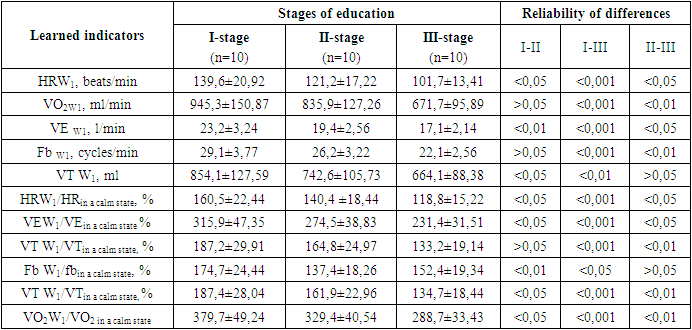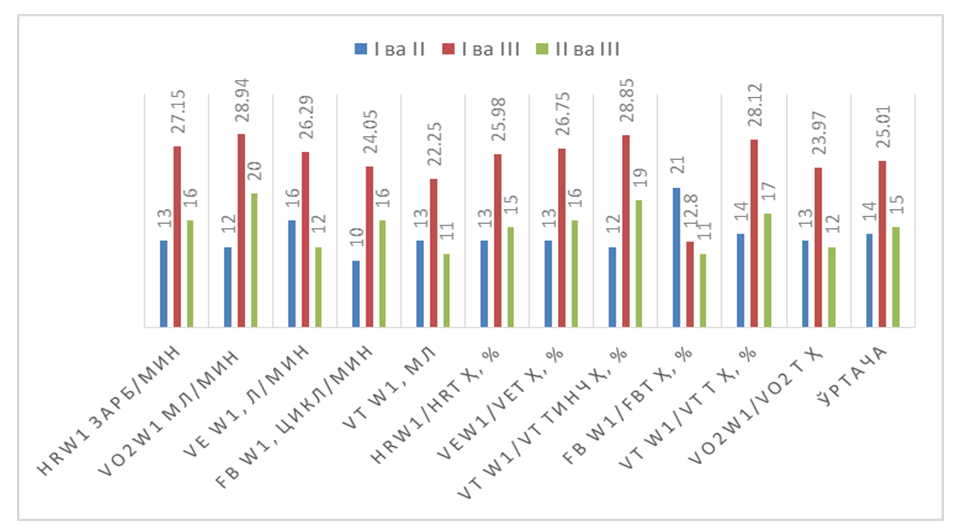-
Paper Information
- Next Paper
- Paper Submission
-
Journal Information
- About This Journal
- Editorial Board
- Current Issue
- Archive
- Author Guidelines
- Contact Us
International Journal of Genetic Engineering
p-ISSN: 2167-7239 e-ISSN: 2167-7220
2024; 12(2): 17-20
doi:10.5923/j.ijge.20241202.02
Received: Feb. 15, 2024; Accepted: Mar. 9, 2024; Published: Mar. 12, 2024

Functional Adaptation Effectiveness of Students with Different Levels of Preparedness for Training During the Adaptation Process
Sultonova Dilfuza
Doctoral Student at Uzbekistan State University of Physical Education and Sport, Uzbekistan
Correspondence to: Sultonova Dilfuza, Doctoral Student at Uzbekistan State University of Physical Education and Sport, Uzbekistan.
Copyright © 2024 The Author(s). Published by Scientific & Academic Publishing.
This work is licensed under the Creative Commons Attribution International License (CC BY).
http://creativecommons.org/licenses/by/4.0/

This article focuses on identifying factors influencing the functional state and effectiveness of students with various levels of preparedness during the training adaptation process. It aims to determine the speed at which these students achieve the necessary changes in their functional parameters.
Keywords: Physical load, Physical preparadness, Functional state, Adaptation, Functional parameters
Cite this paper: Sultonova Dilfuza, Functional Adaptation Effectiveness of Students with Different Levels of Preparedness for Training During the Adaptation Process, International Journal of Genetic Engineering, Vol. 12 No. 2, 2024, pp. 17-20. doi: 10.5923/j.ijge.20241202.02.
1. Introduction
- The ongoing reform of the higher education system significantly influences the intensity of country's educational processes. Coupled with low physical health indicators, this situation is further exacerbated by high exposure to information loads. In this context, the relevance of sports training has become apparent as a means of adapting an athlete's body to physical demands, ultimately enhancing its functionality [1,2,3]. The physiological essence of the long-term adaptation of an athlete's organism's functional systems lies in optimizing the organism's system, with a focus on realizing its functional capabilities and ensuring the unity of reactive properties [3]. To investigate athletes' body functional training, a comprehensive approach was employed, considering functional training in terms of its qualitative characteristics, including strength, mobilization, economy, and stability of functioning.All factors contributing to the high functionality achieved by an athlete as a result of sports training should be realized through an adequate acceleration in the rate at which the body undergoes necessary changes in its functional parameters at the onset of physical stress on physiological systems. During this period, the adaptation of this characteristic of physiological systems emerges earlier as an executive mechanism of homeostatic control. The nature of optimizing the speed at which physical loads induce the necessary changes in their functional parameters at the initial stage of implementation in the adaptation process is based on the enhanced capabilities of the executive components of functional systems [3].The ability of the athlete's body to rapidly undergo necessary changes in functional indicators at the initial stage of performing physical loads, maximizing the mobilization of physiological systems right from the start of work, and swiftly restoring them is crucial for expressing physical performance during sports activities, particularly in exercises accompanied by varying physical loads. Descriptions of these phenomena are largely influenced by variables such as the athlete's training level and the individual-typological characteristics of the organism [3].
2. Research Purpose
- To investigate the level and dynamics of functional indicators in students adapting to specific activities.
3. Research Task
- To determine the speed and dynamics of indicators, enabling athletes with different levels of adaptation to specific muscle activities to achieve the necessary changes in their functional indicators.
4. Methods
- Thirty students from the 1st, 2nd, and 3rd courses, whose age and functional training are similar, and who are studying in the handball specialty at the Uzbek State University of Physical Education and Sports, participated in the research. The selection of handball players aimed to study the influence of age and qualification factors on functional training and its main components. This choice was based on the fact that sports games, including handball, involve movements belonging to cyclic and acyclic physical exercises in approximately equal proportions, allowing the results to be extrapolated to other sports specialties. In addressing issues related to the functional training of athletes, a comparative analysis of the functional training level of various qualified athletes was conducted in a calm state, during muscle work at standard and marginal capacity, and at the recovery stage.In all stages of the studies, dosed three-stage physical loadings were administered based on individual heart contraction frequency (fh) as a functional probe: 1 – load-fh = 120-150 beats/min; 2 – load-fh = 150-170 beats/min; 3 – load-fh > 180 beats/min (maximum). The first two loads lasted 5 minutes each, with a 5-minute break. These load capacities were utilized to calculate the physical performance capability (PWC170) indicators, considering their magnitudes and the corresponding heart contraction frequency levels. The third load was executed at the maximum muscle activity mode (Wmax) and was sustained for 2-3 minutes to achieve peak oxygen consumption values.All recorded indicators post-physical loads were documented during the 5-minute recovery period (V1 – at 1 minute, V5 - at 5 minutes). Initially, athletes' indicators were recorded in a resting state, along with anthropometric measurements (height - L, body mass - R).The conducted work adhered to fundamental bioethical principles, analyzing potential risks and discomfort, explaining research to non-specialists, and obtaining informed consent from participants.The overall physical performance capability was assessed through the PWC170 Test, involving two physical loadings lasting 5 minutes each, each with different capacities. Two muscle loadings with varying capacities were performed, aiming to increase heart contraction frequency to 120-140 beats/min for the first load and 150-170 beats/min for the second load. Testers took breaks of 5 minutes between the loads, and heart contraction frequency was determined post-loading using electrocardiography. The physical performance capability, PWC170 indicator, was calculated using V.L. Karpman et al.'s (1974) formula:PWC170 = W1 + (W2 – W1) х (170 – f1) / (f2 – f1)This equation simplifies the determination of the PWC170 magnitude, provided that the power of the first (W1) and second (W2) loads is known, along with the corresponding magnitudes at the end of the first (f1) and second (f2) loads. The loads were applied on the veloergometer, and the frequency of cardiac contractions (HR) was recorded by electrocardiogram.After completing the second loading as part of the PWC170 test, the test-taker was immediately offered to perform the work at maximum power. Athletes, as a rule, can sustain such a load for 2-3 minutes. During this period, the level of oxygen consumption was recorded, and the maximum capacity of short-term work was determined. The frequency of cardiac contractions (HR) was determined using the electrocardiogram method while the athlete was seated, in operative calm conditions, during the time of reaching the maximum strength of the muscle load in the initiation phase within the first minute of performing a standard-strength physical load, and in the first and fifth minutes of the recovery phase. At all stages of the study, the following parameters of external breathing were measured simultaneously: minute volume of pulmonary ventilation (VE), breath frequency (fb), and breath volume size (VT).The changes involved adding a third stage of physical loading, aiming for a maximum increase in the power of work for 2-3 minutes. In this scenario, heart rate should be ≥ 180 beats/min. All parameters were initially determined in the calm (HRcalm, fbcalm, VTcalm, VEcalm) state of the muscle. At the beginning of the physical load with standard power (first stage), during the execution of the physical load with maximum power (maximum values), and during the recovery phase (first and fifth minutes), the magnitude of the load capacity (W), the frequency of heart contractions (HR), oxygen consumption (VO2), pulmonary ventilation (VE), the frequency of breathing (fb), and and the size of the breath volume (Vt) were recorded.The indicators of functional reactivity and functional mobilization were obtained by calculation as the ratio of the studied parameters to the level of rest during downloads and during the recovery phase.In addition, the absolute magnitudes of HR, VE, FB, VT, and VO2 indicators recorded in the first minute of physical load at standard power have been compared. The main statistical descriptions of the average values of the indicators studied in student-athletes of different ages and different training in the initial phase of performing standard muscle loads, as well as estimates of the statistical reliability of the absolute difference in their average arithmetic values, are presented in Table 1. The relative differences in the arithmetic values of this average are also compared.
|
5. Conclusions
- A comparative analysis of the rate at which the body undergoes necessary changes in its functional parameters in response to physical loads on its physiological systems at standard power revealed a consistent pattern among athletes across different age and qualification groups. The most significant changes were observed in 1st-year student-athletes with a III sports qualification. The rate at which vegetative systems achieve the necessary change in their functional parameters is characterized by a substantial increase in these indicators from 160.5±22.44 to 379.7±49.24% (on average, in the range of 236.5%) during the period of work in a state of relative calm. Similarly, the response of second-year student-handball players' vegetative systems to a physical load at standard capacity is reflected in an average increase of 239.7% (in the range from 137.4±18.26 to 329.4±40.54%) across the analyzed parameters. The rate at which a group of third-year student-handball players with a much higher level of training (I discharge and Sun) achieves the necessary change in their functional parameters is characterized by an average change in the parameters of vegetative systems – from 243.0% (in the range from 118.8±15.22 to 288.7±33.43%).
 Abstract
Abstract Reference
Reference Full-Text PDF
Full-Text PDF Full-text HTML
Full-text HTML
